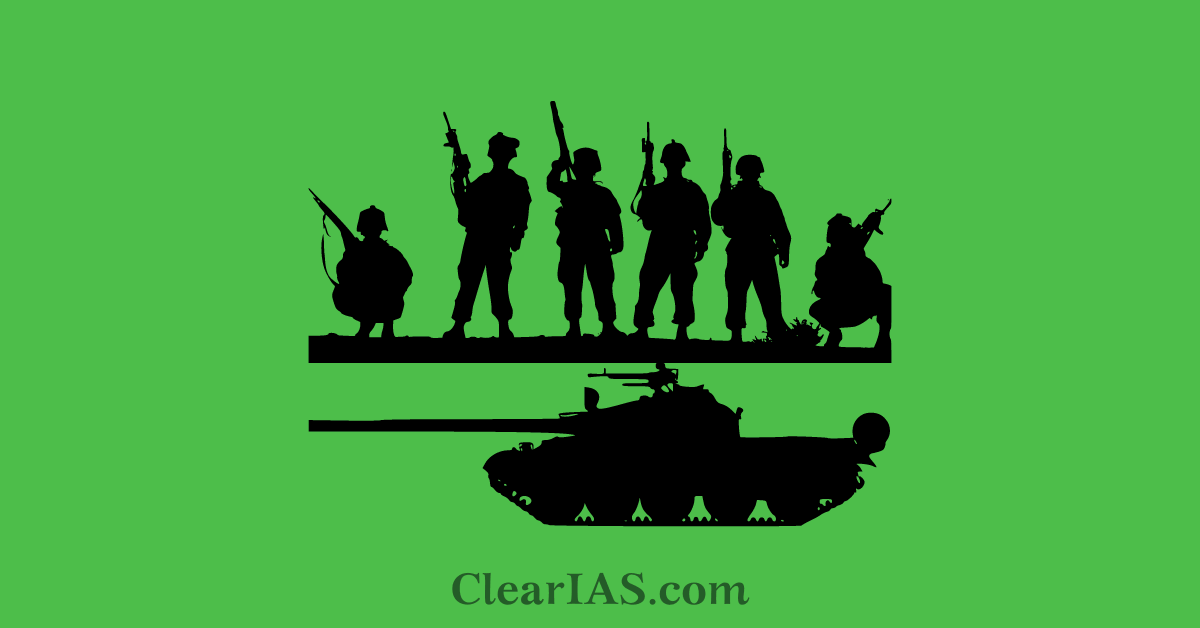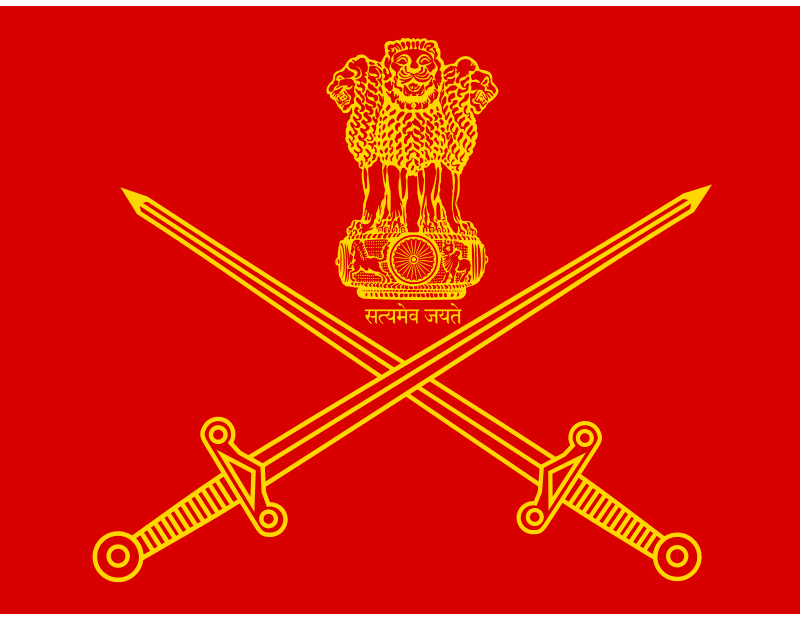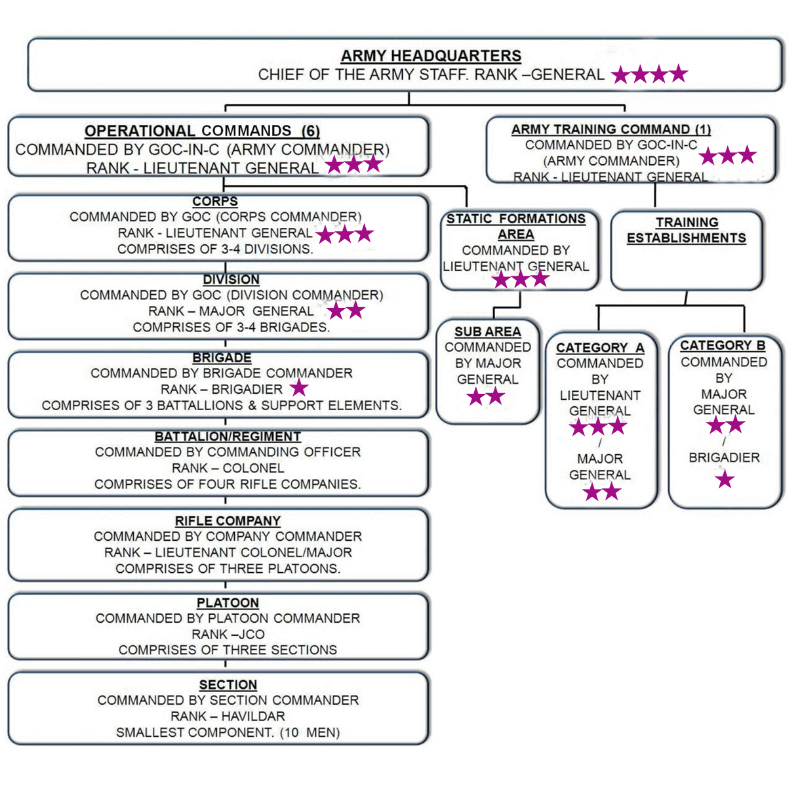 The Indian Army is the largest standing army in the world. Read to know more about the history, structure, and organization of the Indian Army.
The Indian Army is the largest standing army in the world. Read to know more about the history, structure, and organization of the Indian Army.
Indian army is the land-based branch of Indian defence forces. It is the largest of the three armed forces of India (army, air force, and navy).
The primary mission of the Indian army is to defend the nation from external aggression as well as internal threats. It ensures national security and maintains peace within the borders.
The Indian army also conducts rescue operations and humanitarian missions during natural disasters.
The President of India is the Supreme Commander of the Indian Army. The professional head is the Chief of Army Staff, a four-star general. Two officers have been conferred with the five-star rank of Field Marshal to date.
The motto of the Indian Army is “Service before Self”.
The Army Day is celebrated on January 15th every year commemorating the taking over of the position of Commander in Chief of the Indian Army by Field Marshal Kodandera M. Cariappa from General Francis Roy Bucher in 1949.
Ministry of Defence

After independence, the Ministry of Defence was created under the charge of a Cabinet Minister, and each Service was placed under its own Commander-in-Chief.
1955: The Commanders-in-Chief were renamed the Chief of the Army Staff, the Chief of the Naval Staff, and the Air Staff.
1962: The Department of Defence Production was set up to deal with research, development, and production of defence equipment.
1965: The Department of Defence Supplies was created for the planning and execution of schemes for import substitution of defence requirements. These two Departments were later merged to form the Department of Defence Production and Supplies.
1980: The Department of Defence Research and Development was created.
2004: The name of the Department of Defence Production and Supplies was changed to the Department of Defence Production. The Department of Ex-Servicemen Welfare was also created.
Also read: Inter Services Organisations Bill
History of the Indian Army
The Indian Army was a British-commanded force until independence. It comprised locally recruited forces and expatriate British officers.
British Indian Army
The British Indian army has fought in numerous wars like the Anglo Burmese; the Anglo-Sikh wars; the Anglo-Afghan wars; the Opium Wars, and the Boxer Rebellion in China; and in Abyssinia, hence helping maintain British supremacy.
1776: A military department was created within the East India Company at Kolkatta.
1895: The Bengal, Bombay, and Madras Presidency Armies were merged into a single force called the Indian Army. It was divided into four commands- Punjab (Northwest Frontier), Bengal, Madras (with Burma), and Bombay (with Sindh, Quetta, and Aden).
1912: The Prince of Wales Royal Indian Military College was established at Dehradun to provide education to the wards of aristocratic and well-to-do Indian families and to prepare selected Indian boys for admission into the Royal Military College, Sandhurst. Cadets were given a King’s commission, after passing out, and were posted to one of the eight units selected for Indianisation.
1914-18: World War I saw 1.3 million Indian soldiers participate, out of which 74,187 were killed or missing in action. They contributed to European, Mediterranean, Middle Eastern, and African war theatres.
1939-45: During World War II, the Indian soldiers fought with the Allies. India had been pulled into war without the consent of the Indians. This has led to demands for complete independence in return.
Many Indian soldiers deflected during the war to support the independence movement from outside. This led to many joining the Free India Legion in Germany. The Indian POWs joined the Indian National Army in Singapore which was led by Subhash Chandra Bose.
Indian army after independence
After the independence and partition in 1947, four of the ten Gurkha regiments were transferred to the British Army. The rest of the British Indian army was divided between the newly created nations of India and Pakistan.
1947: Indo-Pak war of 1947 or the First Kashmir War saw the Indian army playing a crucial role. An intense war was waged across the state borders. Pakistan suffered significant losses and was stopped on the line formed which is now called the Line of Control (LOC).
1948: After partition, the Nizam of Hyderabad chose to remain independent and maybe join Pakistan later on. The Indian Army troops were ordered by then Deputy Prime Minister Saradar Vllabhai Patel to secure Hyderabad state after the talks between Nizam and the government of India reached a stalemate. The Indian army was backed by the Indian Air Force.
1950: The Indian Army sent its 60th Parachute Field Ambulance unit to aid UN troops during the Korean War (1950-53).
1961: The Army participated in Operation Vijay launched to secure Goa Daman and Diu from the Portuguese.
1962: The Sino- Indian war broke out in the Aksai Chin region (now under Chinese control) and Arunachal Pradesh. The Chinese and Indian troops made incursions beyond the disputed McMahon Line increasing the tensions. However India lost footing in the war because of poor coordination among various divisions of the Indian Army, and the late decision to mobilize the Indian Air Force gave China a crucial tactical and strategic advantage over India. The Line of Actual Control (LAC) came into being after this.
The LAC is generally divided into three sectors:
- The western sector between Ladakh on the Indian side and the Tibet and Xinjiang autonomous regions on the Chinese side.
- The middle, mostly undisputed sector between Uttrakhand and Himachal Pradesh on the Indian side and the Tibet autonomous region on the Chinese side.
- The eastern sector is between Arunachal Pradesh on the Indian side and the Tibet autonomous region on the Chinese side. This sector generally follows the McMahon line.
1965: The Indo-Pak War of 1965 saw the Indian army in all its glory as they launched major and successful offensives. The infamous tank battle, the battle of Asal Uttar, and the largest tank battle, the battle of Chawinda after World War II saw the Indian Army’s victory.
1967: The Cho La incident or the Sino-Indian skirmish was a military conflict between the Indian army and the Chinese People’s Liberation Army in Sikkim. Indian army convincingly ousted the PLA from Sikkim.
1971: The president’s rule of 1971 saw the launch of counter-insurgency Operation Steeplechase by the Indian army and police against Naxalites in the Red Corridor.
The Bangladesh Liberation War of 1971 had heavy involvement of the Indian Armed forces. The Indian army battalions were engaged in clashes on both the eastern and western front, with air support from the Indian Air Force. Many famous battles like the Battle of Longewala were fought.
1984: The Indian army participated in Operation Meghdoot to secure the Siachen glacier from Pakistani incursions. An entire battalion of the Kumaon Regiment was airlifted to the glacier. The Indian Army continues to control all of the Siachen Glacier and its tributary glaciers, which is one of the harshest and inhospitable conditions for the troops to be posted in.
Indian army has played important roles in many counter-insurgency operations over the years, such as Operation Blue Star and Woodrose against Sikh insurgents in the 1980s and Operation golden bird in 1995 in the northeast.
1999: The Pakistani army had captured major vantage points in Kashmir. Once the scale of the Pakistani incursion was realized, the Indian Army quickly mobilized about 200,000 troops, and Op Vijay was launched. However, since the heights were under Pakistani control, India was at a clear strategic disadvantage. But by the end of the Kargil War, all the enemy-occupied areas were back under Indian army control. This war gave rise to many brave and gallant stories of bravery and sacrifice by the Indian army.
2016: The Indian Army carried out surgical strikes in PoK in the terrorist launch pads in response to the terrorist attack on Indian army soldiers in Uri. The final ceasefire was reached in 2018 between both countries.
2017: The Doklam crisis was a border stand-off between the Indian Army and the Chinese PLA over the Chinese construction of a road in Doklam, a trijunction between India, China, and Bhutan. Indian army has launched op juniper to stop the Chinese.
Major exercises of the Indian Army
Op. Brasstacks (1986): It was launched by the Indian Army to simulate a full-scale war on India’s western border. The exercise was the largest ever conducted in India. It included nine infantry, three mechanized, three armored divisions, and one air assault division, as well as three independent armored brigades.
Ex. Nomadic Elephant: The army has been conducting training exercises with the Mongolian army since 2004.
Ex. Yudh Abhyas: The Yudh Abhyas exercise is an ongoing series, since 2005. It is a joint exercise between the Indian and United States armies, agreed upon under the New Framework of the India-US Defence Relationship.
Ex. Shakti: The Shakti exercise is an ongoing series, since 2011, of joint exercises between the Indian and French armies. The exercise is conducted to practice and validate anti-terrorist operations in snowbound and mountainous areas.
Structure of the Indian Army

The Army is operationally and geographically divided into seven commands, with the basic field formation being a division. Below the division level are permanent regiments that are responsible for their recruiting and training.
Future of the army
The theme of the year 2022 is “In stride with the Future”, which signifies the army’s commitment to empowering the force through re-structuring and induction of modern weapon systems for future conflicts.
Emerging technologies, such as Artificial Intelligence, Cyber Warfare, Robotics, and Aerospace, which have the potential for Military application and a disruptive impact on modern-day warfare are being explored and inducted.
To confront multifarious security challenges, the Indian Army is “In Stride with the Future”, fully committed to modernization with an impetus to indigenous solutions.
F-INSAS (Future Infantry Soldier As a System) is the Indian Army’s principal infantry modernization program, which aims to modernize the army’s 465 infantry and paramilitary battalions by 2020.
India is also reorganizing the mechanized forces to achieve strategic mobility by progressively deploying more Arjun main battle tanks (MBT). It also aims to develop and deploy the Arjun MK-II variant, as well as 1,657 Russian-made T-90 S MBTs.
Many weapons programs are going on such as:
- Arjun MK-IA, the main battle tank (MBT)
- Futuristic Battle Tank (FMBT), FMBT will be a lighter tank of 50 tons.
- Abhay IFV, the Future Infantry Combat Vehicle
- TATA Kestrel is a modern armored personnel carrier (APC) developed by Tata Motors and the Defence Research and Development Organisation (DRDO).
- Light Utility helicopters (LUH) to replace chetak and cheetah helicopters.
- HAL LUH for the army and air force
- HAL Light combat helicopters for the army.






Leave a Reply